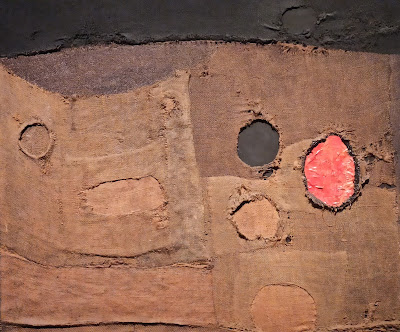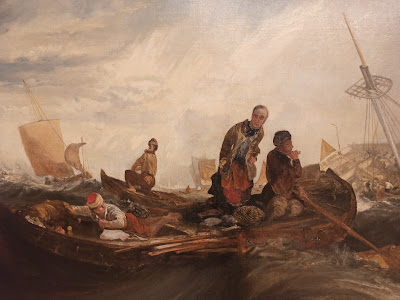Visited the St Francis exhibition which I really enjoyed. The exhibition explores how St Francis has been perceived in art history. (Pope Francis took his name).
St Francis was born in Assisi in Italy. The son of a rich textile merchant, the young Francesco probably had a decent comfortable childhood. As a young man though, he wanted to take part in the Crusade as a knight. Participation of which, at the time, was considered one of the highest honours in Christianity. Thus, he tried to reach the court of Gualtieri III, Count of Brienne in Lecce, to move with the other knights to Jerusalem. However, as he arrived at Spoleto, he fell ill, and received nocturnal revelations at the church of San Sabino. He nevertheless joined the army, and fought, and was then taken prisoner for a year. Upon release, he started to pray to God. Later, he performed his miracles like taming the wolf and receiving the Stigmata. St Francis even visited Egypt to negotiate tensions between Muslims and Christians, and thus granted an audience with the Sultan Al Kamil.
He claimed that Christ spoke to him via a wooden crucifix to rebuild the Christian faith. Canonized in 1228 (only 2 years after death!), founder of the order of Franciscans, mentor of St Clare; today he embodies the ascetic lifestyle and poverty for God and kindness to the creation. What is true and what is myth and legend, we'll never know.
Born a millennia after Christ, this near cult-like following arose at a convenient historical juncture. As the nascent Franciscan movement grew, the arts had began to occupy a greater prominence in conveying the myth and legend of St Francis, not least the Franciscan ethic of poverty. Moreover, at the time, the Catholic Church was directed against a more potent challenge to their authority, namely the heresies of the Cathars. When Pope Honorius III approved the Franciscans and Dominicans – as something of a challenge – it was merely to better deal with the Cathars and to constraint the mendicant preaching in line with Canon.
✲✲✲
Saint Francis in Meditation by Francisco de Zurbarán
As the gallery says, a near perfect illustration of St Francis.
Kneeling, darkened still ambience, torn and worn habit, eyes heavenward, deep reverential contemplation, mouth ever-so-slightly ajar (as though to whisper), memento mori.
It's a very powerful depiction and I think it makes that it's placed at the entrance of the exhibition.
✲✲✲
The Altarpieces of St. Francis of Assisi by Sassetta
Visual biographies of the life of St Francis. They're very beautiful and sweet. These are considered to be Sassetta's masterpiece.
Quite beautiful and poignant, and a pretty impressive round-up of the Saint's life. The paints are:
- The young Francesco. As per his biographer, he gives his fine clothes to a poorer knight.
- St Francis abandons everything – including his clothes – and leaves his sublunary father for the eternal one. The embodiment of poverty and sacrifice for God. The actual father is angry at this Francis (understandably!).
- St Francis – older now in his friar's habit – meets Pope Honorius III who grants him permission to establish his order.
- Francis before the Sultan in Egypt during the 5th crusade offering to pass through fire.
- The wolf of Gubbio. Legend here is that Francis tamed a ferocious wolf that was terrorising a community. Birds hovering above also.
✲✲✲
Saint Francis and the posthumous miracles
Byzantine altarpieces are ornately decorated with meticulous care and detail. They date back to the mid-13th century. Beautiful in their own way. In them, St Francis draped in poverty, stigmata and books in one hand. The miracles are (1) healing a girl with a twisted neck, (2) disabled man with leprosy, (3) an exorcism (bottom right-hand side, showing demons exiting her mouth).
✲✲✲
St Francis of Assisi with Angels by Sandro Botticelli
Painted gold background. Botticelli gives us more refined features, a slightly skinny St Francis, bony feet with angels musicians encircling a contemplative Francis.
✲✲✲
After the Council of Trent (which gave renewed emphasis to the arts mostly in opposition to the Protestant reformation), St Francis's portrayal grew.
St Francis of Assisi in Ecstasy by Caravaggio
Caravaggio painted Francis post stigmata and recumbent. He seems overcome with the pain of the ordeal. There is a tenderness to this painting. Brother Leo, in the background, subtlety looking upset.
It's interesting; but I don't think it is amazing.
✲✲✲
St Francis Embracing Christ on the Cross by Bartolomé Esteban Murillo
A lot of allusions and imagery in this painting of classical elegance. Francis close enough to be touching Christ. One foot on the globe. The Christ resting a hand on his shoulder for support. As above, there is that feeling of affection and compassion, perhaps even continuing Christ's work for him.
✲✲✲
St Francis Receiving the Stigmata by Frans Pourbus the Younger
A dramatic arresting painting capturing the moment of the stigmata. This was painted for Convent of the Annunciation in Paris. It seems to me to glorify and exalt the terrestrial suffering and pain in favour of the the heavenly bliss and ecstasy. Perhaps self-abnegation has egoism in it?
St Francis's face in calm acceptance and arms surrendered. The wounds visible including on the chest, replicating Christ's wounds. Though, it occurs to me no blood from the crown of thorns? At any rate, his sandals are also brushed aside, as per Moses. Another memento mori with Brother Leo shielding his eyes.
This is a painting of devotion. Quite stirring.
✲✲✲
St Francis' Vision of the Musical Angel by Francisco Ribalta
Ailing skinny St Francis receives musical angels. Poverty and hardship all around (Brother Leo reading from a single candle) and the burst of energy (blowing hair and clouds), light and music from the left. Lamb being the symbol of meekness, Moses and shepherd-ness.
Painted in Spain, this must have had an inspiring dazzling effect on the viewers. I think it's pretty good; but not amazing as the Zurbarán.
✲✲✲
St Francis receiving the stigmata by El Greco
Quite an original Spanish depiction painted in approx 1590. Azure skies and clouds enveloping Francis with a heavenward devotional gaze.
It's interesting, but I can't say I like it that much.
✲✲✲
Brother Francis and Brother Son by Giovani Costa
The painter Costa was, apparently, "imbued with the Franciscan spirit". Francis supposed to be greeting the Brother sun.
This painting is charming for 5 mins and then I find it annoying. Its a bit too Disney-like.
✲✲✲
The Wolf of Gubio by Luc-Olivier Merson
Charming painting which is supposed to depict one of Francis's supposed miracles; the taming of a wolf. The taming of any wolf surely does not necessarily entail divine providence? Anyway, the wolf has a halo and is passively eating some meat from the butcher. The wolf, it seems, entered a bargain as opposed to being fully tamed!
I love the mother and daughter interaction, and the general village romantic charm.
✲✲✲
The Habit of St Francis
This habit is from the 13th century, and belongs to the Franciscans in the Basilica of Santa Croce in Florence.
According to the National Gallery, it is reputed to be the very habit that St Francis himself wore. This seems unlikely.
Whilst it's interesting to see this object (which is admittedly rare), it did feel incongruous in the gallery. I felt it should sit or belong in a church as an object of religious significance. I can't see any obvious artistic value. Whilst it does sit in a golden frame, I can't be the only one to find it a bit distasteful.
✲✲✲
Sacco (sack) by Alberto Burri
This modern canvass sits discordantly among the more classic art.
Burri is supposed to have fought in the world war, and taken prisoner of war. Although he didn't expressly identify this piece with Francis; parallels were drawn with the habit of Francis.
It seems he did offer it as an exhibition at a Franciscan friary in Assisi; Sacro Convento. But of course, it may have had nothing to do with Francis. To me, it seems a bit tangential, and didn't fit in with the rest of the exhibition. A sack could just be a sack; the problem with this kind of modern art.
✲✲✲
Franciscan and the Indian by Jose Clemente Orozco
1926 painting by Mexican artist. Invokes Francis's initial horror at a sick disabled man with leprosy; but then embraces the emaciated man in a show of compassion. There is something very moving in the embrace; beneficent and tender in the wrapped arms in the larger-than-life figure. One feels a sense of dejection and compassion.
✲✲✲
Francis, Brother of the Universe (1980)
St Francis meets the Marvel universe in Tokyo with his superhuman characteristics.
A funny endnote to the exhibition.




















.png)
.png)


















































